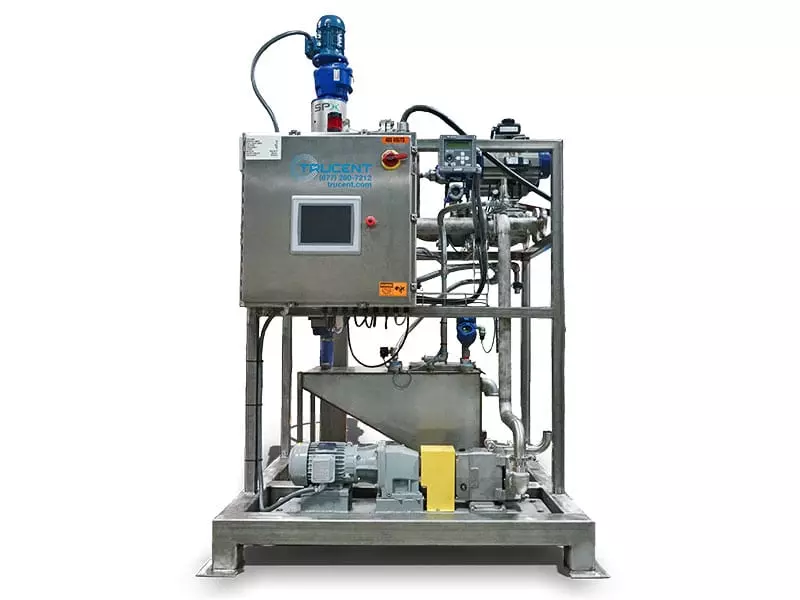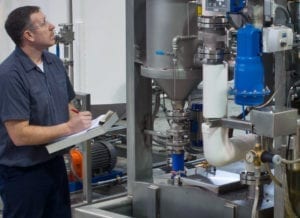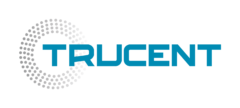
Centrifuges and tricanters are a significant investment. You want them to run—and run well—for as long as possible. But far too many ethanol plants are overworking their centrifuges or tricanters when extracting distillers corn oil (DCO).
Adding a DCO syrup conditioner to your extraction system is a step in the right direction. A syrup conditioning module removes large particles from your syrup, which reduces your syrup stream’s viscosity and improves oil droplet size, resulting in increased separation efficiency and improved DCO quality overall. It also protects the rest of your line from clogs and the resulting downtime.
Innovative Conditioning Solutions Protect Extraction Systems and Increase Yield
The TruShield-SC is a high-efficiency syrup conditioning tool optimized to reduce particle size and viscosity. This tool increases the efficiency of corn oil ethanol extraction, which then saves you demulsifier chemistry. It’s easily installed in front of any centrifuge or DCO extraction system, takes up little floor space, and seamlessly integrates with all plant designs. In the end, a TruShielf-SC quickly pays for itself by improving both extraction-separation efficiency and increasing corn oil co-product yield while decreasing maintenance and unscheduled downtime.
 But having the right equipment is just one piece of the puzzle. Can you keep that equipment reliably running at its peak? Are you sure that every module in your DCO extraction solution is performing?
But having the right equipment is just one piece of the puzzle. Can you keep that equipment reliably running at its peak? Are you sure that every module in your DCO extraction solution is performing?
Service has been the backbone of our business for decades. That starts with our Technology Service Program (TSP), a service program designed to maximize uptime, reliability, and production through operations and maintenance support.
And we can go even further: Trucent engineers can help you redesign and optimize your entire DCO extraction system. We offer an unparalleled DCO extraction tracking program. This analytical capability takes the guesswork and variability out of your DCO process by building an ongoing record of your syrup quality, the factors affecting your process, and evaluating every change in your corn oil production. Together, this data gives you unparalleled insight into what’s happening inside your process.
No one else offers DCO extraction services this effective or comprehensive.
Using Our Processes to Help You Improve Yours

At Trucent, we’re dedicated to a process-oriented approach. That approach hinges on our teams, who bring decades of experience to every challenge. These are equipment experts, engineers, leading researchers making discoveries in the fundamental chemistry of fluid separation, and experienced ethanol/DCO technicians. Our team will work with your team to find the best solutions to your ethanol and DCO challenges.
Every solution begins with a conversation. Contact us today to start a conversation about your DCO/syrup conditioner needs or schedule a no-obligation on-site consultation.
Video: How the TruShield-SC WorksDownloads
Maximize Corn Oil Recovery with Comprehensive Trucent Solutions
Trucent delivers the most comprehensive corn oil extraction, ethanol separation, and syrup-conditioning solutions on the market. By installing TruShield-SC, you can improve the results you get from your existing ethanol corn oil centrifuge—while protecting your equipment from unnecessary wear. Whether it’s adding just one piece of equipment—or designing an entirely new ethanol extraction system—our goals for you remain the same: Higher quality, increased yield, lower costs, and durable efficiency for the long haul.

Third COSS Module Adds $1.2M in DCO Annually
Adding a third Corn Oil Separation System (COSS-SL) module helps Midwestern ethanol producer generate $1.2M annually and decrease additive costs by $300K.
Within weeks, the third COSS installation and integration was compatible and produced 24% more DCO (limited by feed fat feed tag requirements). In addition, a 70% reduction in chemical usage was achieved.






